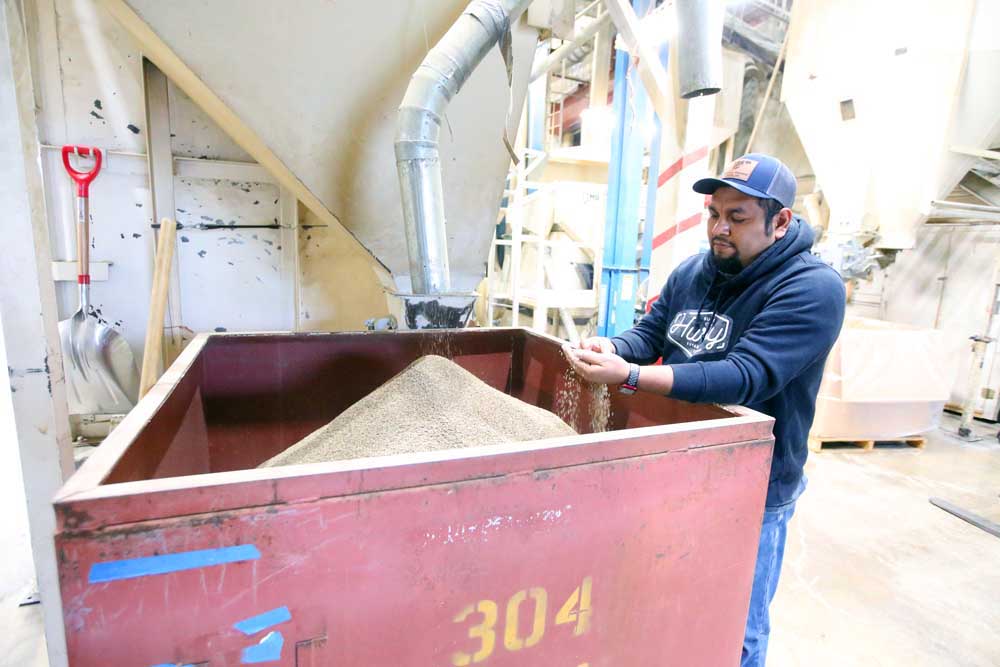Lucrative carrot seed contracts could help North Unit farmers as other commodities drag
Published 4:30 am Wednesday, January 15, 2025

- Central Oregon Seeds Inc. Machine Operator, Manuel Diaz, checks the quality of carrot seeds being processed, in the plant at Central Oregon Seeds Inc. in Madras Monday afternoon. 1-13-25
For the past few years, North Unit Irrigation District farmer Phil Fine has struggled to keep his business afloat. Low water allocations and drought have forced him to leave half his acres empty. Weak commodity prices result in little profit for what he can grow. But this year he’s hoping to get through the year with help from an old standby crop — carrot seed.
Amid tanking prices for wheat, hay, grass seed and other familiar products grown by North Unit farmers, carrot seed is having a moment. While prices are rarely disclosed, multiple farmers interviewed by The Bulletin said growing carrot seed remains profitable while other crops deliver at cost or negative returns.
Very stable prices
“Carrot seed prices are very stable,” said Fine, a North Unit farmer whose specialties include hay, carrot seed and grass seed. “If nothing else, they’ve actually come up a little. They’ve actually come up in the last few years just because of the expense to grow them.”
Fine said the cost of farming has risen over the past year no matter what is grown. Labor costs are higher along with bills for energy, fuel and water. But carrot seed contracts have managed to rise along with the cost of production.
Read More: Jefferson County drought could affect global seed supply
The same cannot be said for all other locally grown products. Hay, for example, sold for around $300 per ton two years ago and has fallen to just $150 this year, said Fine.
Stability in seed prices are partially due to the way contracts are negotiated between the carrot companies, seed processors and seed sellers. While carrot companies mostly control prices, a middle ground must also be reached with seed producers and processors to ensure the seeds can be grown without losses.
Fine says although just 10% of his acres this year will be dedicated to carrot seed, that small percentage of acres will likely result in 40% of his income.
A third of his acres will be planted with grass seed and 20% will be hay. The remaining acres will be planted with wheat and other small grains, and some acres will have cover crops for future use.
Carrot seed downsides
Carrot seed is a perennial favorite among North Unit growers — around half of the world’s carrot seed supply comes from Jefferson County. But if the price of carrot seed is good, why aren’t farmers planting more acres of carrots for seed?
Carrot seed may fetch a good price today but Fine says it’s a risky crop to grow at a large scale. The plants aren’t the easiest crop to grow and they are known to fail for a variety of reasons.
“They (carrot seed plants) can be kind of fickle,” he said. “You can have an outstanding looking stand of carrots and then you don’t get good germination. You don’t get good seed set. There’s a lot of variables.”
Wildfire smoke is one of those variables — too much of it can weaken a crop. Another variable is pollination, also and unpredictable factor. In high temperatures, the bees brought to a farm may not pollinate. They may prefer to stay in the hive and keep it cool.
“You don’t make seed without bees. So there are a lot of environmental factors in there and timing. Timing on carrots is huge,” Fine said. “If your timing’s a little off on pollination, bees, seed set, environmental factors, bugs all play a factor in it. There is a lot that goes into it, it’s all about risk management.”
Planning for a good crop
Ken Stout, the chief executive officer for Central Oregon Seed, Inc., a seed processing company based in Madras, hopes the season turns out well for farmers. He’s responsible for getting Jefferson County carrot seeds (and other seed products) out into the world. This year, thanks to a wet winter and ample snowpack, his hopes have a better-than-average chance of coming to fruition.
Stout said his company contracts both vegetable seeds and grass seed from its facility in Madras. Vegetable seeds are largely insulated from the volatilities seen in the price of wheat and hay.
Seed prices are also “more immune to oversupply issues and the normal type of commodity market influences,” he said. “Therefore prices hold up well and are very stable compared to other things.”
Carrot seed prices have generally increased with inflation, said Stout, allowing growers to earn more income when their own costs rise. The additional income from carrot seed also helps when grass seed prices are in decline, he said.
“For many of the growers up here, not all, but many of the growers (carrot seed) is a very important block in their foundation of having a good cropping system,” said Stout. “And there’s probably more reliance on it now because of the other commodity and grass seed prices. I think with those down it’s become a more important piece.”
Staying optimistic
In another part of Jefferson County, Kevin Richards is also laying the groundwork for his 2025 growing season. He knows this year will be another one with slim margins but continues to put in the effort believing that market pricing could shift in a year or two.
“My farm is continuing to emphasize the higher value crops like the vegetable seed so that we can justify the higher input costs,” said Richards, who grows a variety of seed crops, including grass, carrot and parsley. “Hopefully there’s more water, and commodity prices start to recover, that’s the path forward. But it’s not going to happen in 12 months.”
For the time being, farmers can seek federal assistance. This includes crop insurance provisions in the Farm Bill, which has $10 billion in farm economic assistance to offset low commodity prices.
With that assistance must come optimism.
“There’s always opportunity or else maybe we would just throw our hands up in the air,” said Richards, adding his own practical philosophy in an unpredictable occupation — “Keep your head up, manage your risk, and stay optimistic.”
The carrots planted by seed farmers aren’t actually eaten. Carrots are biennials meaning they produce their seeds in their second year of growth. In other words, farmers must grow a perfectly edible carrot only to leave it in the ground all winter — the carrot plant then produces seeds in its second year, during which time, the edible carrot root dries up.








